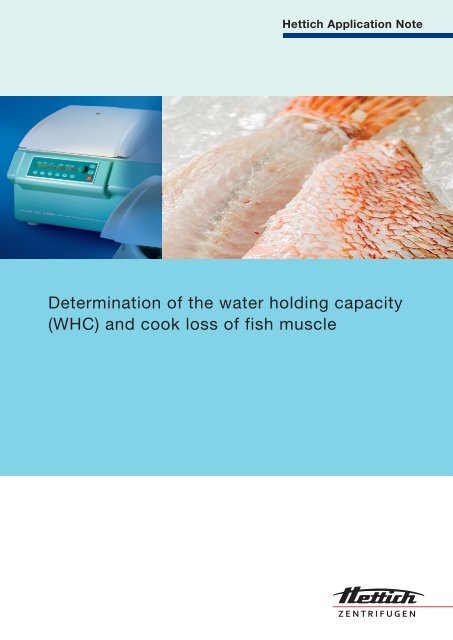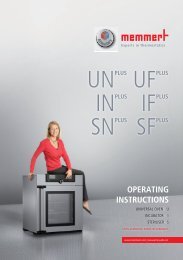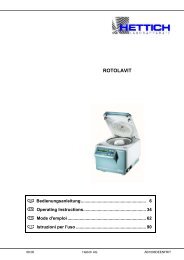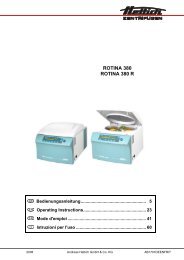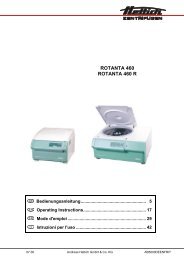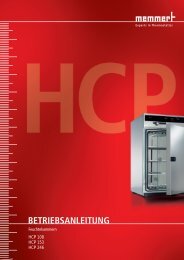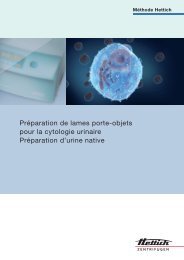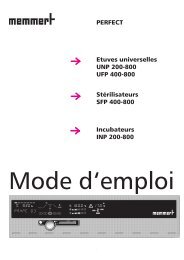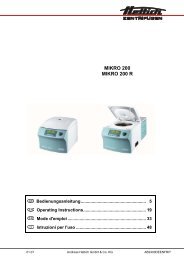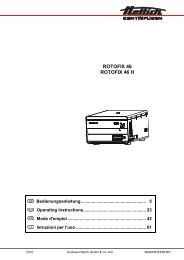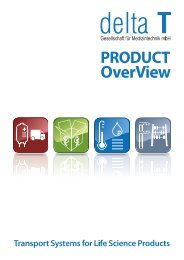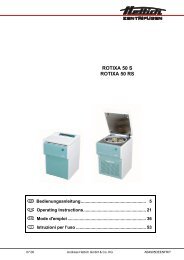Determination of the water holding capacity (WHC ... - Hettich AG, CH
Determination of the water holding capacity (WHC ... - Hettich AG, CH
Determination of the water holding capacity (WHC ... - Hettich AG, CH
Create successful ePaper yourself
Turn your PDF publications into a flip-book with our unique Google optimized e-Paper software.
<strong>Hettich</strong> Application Note<br />
<strong>Determination</strong> <strong>of</strong> <strong>the</strong> <strong>water</strong> <strong>holding</strong> <strong>capacity</strong><br />
(<strong>WHC</strong>) and cook loss <strong>of</strong> fish muscle
<strong>Determination</strong> <strong>of</strong> <strong>the</strong> <strong>water</strong> <strong>holding</strong> <strong>capacity</strong> and cook loss <strong>of</strong> fish muscle<br />
The determination <strong>of</strong> <strong>the</strong> <strong>water</strong> <strong>holding</strong> <strong>capacity</strong><br />
(<strong>WHC</strong>) is an established method <strong>of</strong> investigating <strong>the</strong><br />
degree <strong>of</strong> denaturation <strong>of</strong> proteins in muscle tissue.<br />
Although <strong>the</strong> emphasis to date has been on raw<br />
material, <strong>the</strong> method described here and <strong>the</strong><br />
corresponding sample cups have been specially<br />
developed for cooked samples.<br />
Where convenience meals are prepared from fish<br />
products, for example, <strong>the</strong> quality <strong>of</strong> <strong>the</strong> fish must<br />
be kept at a high level. Quality controls are <strong>the</strong>refore<br />
essential at various stages in <strong>the</strong> production<br />
process. Heating in particular causes changes to<br />
muscle tissue through denaturation <strong>of</strong> <strong>the</strong> proteins.<br />
The fish muscle should not disintegrate after<br />
cooking and remain tender.<br />
A determination <strong>of</strong> <strong>the</strong> <strong>WHC</strong> and cook loss allows<br />
conclusions to be drawn about <strong>the</strong> degree <strong>of</strong><br />
denaturation <strong>of</strong> <strong>the</strong> proteins and <strong>the</strong>refore <strong>the</strong><br />
quality <strong>of</strong> <strong>the</strong> fish. It is <strong>the</strong>refore an objective and<br />
reproducible method.<br />
Carrier 4750 with lid 4751 and special accessories<br />
for determination <strong>of</strong> <strong>WHC</strong>.<br />
<strong>Hettich</strong> products to determine <strong>the</strong><br />
<strong>WHC</strong> and cook loss <strong>of</strong> fish muscle:<br />
Advantages <strong>of</strong> <strong>the</strong> method<br />
This method enables <strong>the</strong> <strong>WHC</strong> and cook loss <strong>of</strong> heat<br />
treated samples to be determined precisely. The methods<br />
used to date have been for investigation <strong>of</strong> raw samples<br />
and are unsuitable for a study <strong>of</strong> <strong>the</strong> kinetics <strong>of</strong> cook loss<br />
and <strong>the</strong> <strong>WHC</strong> <strong>of</strong> cooked samples since <strong>the</strong>se require a<br />
rapid and uniform heating <strong>of</strong> <strong>the</strong> sample.<br />
The special design <strong>of</strong> <strong>the</strong> newly-developed sample cups<br />
ensures that heat is transferred quickly and uniformly<br />
from <strong>the</strong> heating medium to <strong>the</strong> sample. The changes<br />
in quality as a result <strong>of</strong> <strong>the</strong> heating can <strong>the</strong>refore be<br />
determined precisely and <strong>the</strong> manufacturing processes<br />
changed where necessary.<br />
By courtesy <strong>of</strong> N<strong>of</strong>ima Norconserv AS, Måltides Hus,<br />
Richard Johnsens gt 4, 4021 Stavanger.<br />
The new formula described by Skipnes et al. 1) factors<br />
<strong>the</strong> cook loss into <strong>the</strong> calculation <strong>of</strong> <strong>the</strong> total <strong>WHC</strong><br />
(<strong>WHC</strong> TOT<br />
) directly.<br />
1) Skipnes D., Østby M. L., Hendrickx M. E. 2007: A method for characterising cook loss and <strong>water</strong> <strong>holding</strong> <strong>capacity</strong> in heat treated cod (Gadus morhua) muscle,<br />
in: Journal <strong>of</strong> Food Engineering, Volume 80, Issue 4, P. 1078-1085.<br />
2
<strong>Determination</strong> <strong>of</strong> <strong>the</strong> <strong>water</strong> <strong>holding</strong> <strong>capacity</strong> and cook loss <strong>of</strong> fish muscle<br />
The sample cup<br />
The centrifuge tubes used to date for a<br />
determination <strong>of</strong> <strong>the</strong> <strong>WHC</strong> were expensive<br />
custom-made products and required<br />
transfer <strong>of</strong> <strong>the</strong> sample between heating<br />
and centrifugation. The sample cups<br />
developed specifically for this method<br />
<strong>of</strong>fer considerable advantages:<br />
Bottom lid<br />
in base position<br />
Bottom lid in<br />
extended<br />
position<br />
· Simple and exact determination <strong>of</strong> <strong>the</strong><br />
<strong>water</strong> <strong>holding</strong> <strong>capacity</strong>.<br />
Filter insert<br />
· Iso<strong>the</strong>rmal heating in sample cup without<br />
<strong>the</strong> need to transfer samples between<br />
heating and centrifugation.<br />
· Rapid heating in a <strong>water</strong> bath and direct<br />
analysis <strong>of</strong> <strong>the</strong> following parameters<br />
- Water <strong>holding</strong> <strong>capacity</strong><br />
- Cook loss<br />
- Texture<br />
- Colour.<br />
· No liquid loss from <strong>the</strong> sample cup.<br />
Sample cup<br />
Top lid<br />
· No absorption <strong>of</strong> liquid into <strong>the</strong><br />
sample cup.<br />
Fig. 1: Design <strong>of</strong> <strong>the</strong> sample cup<br />
· Easy to clean.<br />
· High mechanical durability,<br />
allowing higher centrifugal forces.<br />
Fig. 2: Bottom lid in base position (left)<br />
and in extended position (right)<br />
This flexible solution allows adaptation to different<br />
sample quantities and ensures an optimal heat<br />
transfer during <strong>the</strong> heating process.<br />
3
<strong>Determination</strong> <strong>of</strong> <strong>the</strong> <strong>water</strong> <strong>holding</strong> <strong>capacity</strong> and cook loss <strong>of</strong> fish muscle<br />
Preparation<br />
1. Preparation <strong>of</strong> <strong>the</strong> fish sample<br />
Cut <strong>the</strong> raw fish sample into pieces or cut samples so<br />
that <strong>the</strong>y have a diameter <strong>of</strong> 31 mm. Weigh out approx.<br />
5 g <strong>of</strong> muscle tissue with a total height <strong>of</strong> approx. 6 mm.<br />
The muscle tissue should be homogeneous and free<br />
<strong>of</strong> fat and connective tissue.<br />
2. Preparation <strong>of</strong> <strong>the</strong> sample cups<br />
The sample cups should be kept on ice until use.<br />
Before filling with <strong>the</strong> sample, <strong>the</strong> top lid is screwed<br />
onto <strong>the</strong> sample cup. If <strong>the</strong> temperature in <strong>the</strong> sample<br />
is being measured <strong>the</strong>n <strong>the</strong> top lid with <strong>the</strong> opening<br />
for <strong>the</strong> temperature sensor should be chosen. Weigh<br />
<strong>the</strong> sample cup with <strong>the</strong> top lid (weight g 1<br />
).<br />
3. Filling <strong>the</strong> cup with <strong>the</strong> sample<br />
Invert <strong>the</strong> sample cups (<strong>the</strong> top lid now forms <strong>the</strong> bottom),<br />
fill it with <strong>the</strong> prepared sample material and weigh <strong>the</strong><br />
sample cups again (weight g 2<br />
). Screw in <strong>the</strong> filter until it<br />
makes contact with <strong>the</strong> sample.<br />
Now screw in <strong>the</strong> bottom lid as far as it will go (until it is<br />
in contact with <strong>the</strong> filter) and weigh <strong>the</strong> sample cups again<br />
(weight g 3<br />
).<br />
Note: Ensure that no air bubbles form on <strong>the</strong> sample<br />
cup in <strong>the</strong> <strong>water</strong> bath as <strong>the</strong>y would prevent uniform<br />
heat exchange.<br />
5. Removal <strong>of</strong> <strong>the</strong> exudate<br />
Remove <strong>the</strong> sample cup from <strong>the</strong> <strong>water</strong> bath and allow<br />
it to cool in ice <strong>water</strong> at 0 – 1.8 °C and <strong>the</strong>n dry <strong>the</strong><br />
outside <strong>of</strong> <strong>the</strong> cup well. Unscrew <strong>the</strong> lower lid and allow<br />
<strong>the</strong> liquid that has been released by <strong>the</strong> sample during<br />
heating to drop out <strong>of</strong> <strong>the</strong> cup for 30 seconds. Wipe <strong>the</strong><br />
remainder <strong>of</strong> <strong>the</strong> exudate from <strong>the</strong> lower lid and inside<br />
wall <strong>of</strong> <strong>the</strong> sample cup. Ensure that you do not touch <strong>the</strong><br />
filter during <strong>the</strong> drying procedure. Weigh <strong>the</strong> sample in<br />
<strong>the</strong> sample cups toge<strong>the</strong>r with <strong>the</strong> dried lid (weight g 4<br />
).<br />
6. Centrifugation<br />
Screw <strong>the</strong> bottom lid back on, this time in its base<br />
position and centrifuge for 15 minutes at 1800 min -1<br />
and 4 °C.<br />
Fig. 4 shows a longitudinal section through <strong>the</strong> sample<br />
cup, assembled for <strong>the</strong> centrifugation. The bottom<br />
lid (s<strong>of</strong>t and dark grey) is in base position. The liquid<br />
lost by centrifugation will be collected in <strong>the</strong> space<br />
between bottom lid and filter (blue).<br />
Fig. 3 shows a longitudinal section through <strong>the</strong> sample<br />
cups, assembled for <strong>the</strong> heating process. The bottom lid<br />
(dark grey) is extended till it meets <strong>the</strong> filter (blue).<br />
Note: The filter and <strong>the</strong> sample should be in good contact,<br />
but <strong>the</strong> sample must not be subject to any pressure.<br />
Fig. 4: Longitudinal section through <strong>the</strong> sample cup<br />
assembled for centrifugation<br />
7. Removal <strong>of</strong> <strong>the</strong> exudate<br />
Fig. 3: Longitudinal section through <strong>the</strong> sample cup<br />
assembled for <strong>the</strong> heating process<br />
4. Heating <strong>of</strong> <strong>the</strong> sample<br />
The sample cup is placed for a specific period <strong>of</strong> time<br />
in a <strong>water</strong> bath preheated to <strong>the</strong> required temperature<br />
(e.g., 10 minutes at 80 °C).<br />
After centrifugation, weigh <strong>the</strong> sealed sample cup.<br />
Unscrew <strong>the</strong> bottom lid in which <strong>the</strong> liquid that was<br />
lost during centrifugation has collected, and allow <strong>the</strong><br />
sample to stand for 30 sec so that <strong>the</strong> liquid can drain.<br />
Wipe <strong>the</strong> remainder <strong>of</strong> <strong>the</strong> exudate from <strong>the</strong> bottom<br />
lid and <strong>the</strong> inside wall <strong>of</strong> <strong>the</strong> sample cup. When drying<br />
<strong>the</strong> inside <strong>of</strong> <strong>the</strong> cup ensure again that <strong>the</strong> filter is not<br />
touched. Weigh <strong>the</strong> sample in <strong>the</strong> sample cup toge<strong>the</strong>r<br />
with <strong>the</strong> dried lid.<br />
Steps 4 and 5 are omitted for <strong>the</strong> determination<br />
<strong>of</strong> <strong>the</strong> <strong>WHC</strong> <strong>of</strong> raw samples.<br />
The special design <strong>of</strong> <strong>the</strong> sample cup and <strong>the</strong> lid enable<br />
optimum heat exchange.<br />
4
<strong>Determination</strong> <strong>of</strong> <strong>the</strong> <strong>water</strong> <strong>holding</strong> <strong>capacity</strong> and cook loss <strong>of</strong> fish muscle<br />
Calculations<br />
1. <strong>Determination</strong> <strong>of</strong> cook loss<br />
The cook loss is <strong>the</strong> difference between <strong>the</strong> g 3<br />
value<br />
and <strong>the</strong> g 4<br />
value. The weight <strong>of</strong> <strong>the</strong> sample is given<br />
by g 2<br />
minus g 1<br />
. The percentage weight loss can <strong>the</strong>refore<br />
be calculated from <strong>the</strong>se values.<br />
2. <strong>Determination</strong> <strong>of</strong> <strong>WHC</strong> <strong>of</strong> raw samples<br />
The <strong>WHC</strong> <strong>of</strong> raw samples is calculated as <strong>the</strong> ratio<br />
<strong>of</strong> <strong>the</strong> <strong>water</strong> remaining after centrifugation to <strong>the</strong> initial<br />
<strong>water</strong> content <strong>of</strong> <strong>the</strong> sample, using <strong>the</strong> following<br />
formula 2) :<br />
W<br />
<strong>WHC</strong> TOT<br />
= 0<br />
– W TOT<br />
100 % ;<br />
where<br />
V 0<br />
D 0<br />
C 1<br />
W 0<br />
V<br />
W TOT<br />
= 1<br />
+ C 1<br />
100 ;<br />
= Initial <strong>water</strong> content <strong>of</strong> <strong>the</strong> sample<br />
= Initial dry mass <strong>of</strong> <strong>the</strong> sample<br />
V 1<br />
= Water loss from <strong>the</strong> heated sample<br />
through centrifugation<br />
= Weight loss on cooking <strong>of</strong> <strong>the</strong> sample<br />
This leads to <strong>the</strong> following new definition<br />
<strong>of</strong> <strong>water</strong> <strong>holding</strong> <strong>capacity</strong>:<br />
V 0<br />
+ D 0<br />
5<br />
V 0<br />
– ( V 1<br />
– C 1<br />
)<br />
<strong>WHC</strong><br />
W 0<br />
– W<br />
TOT<br />
= 100<br />
V<br />
<strong>WHC</strong> = 100 %<br />
0<br />
W 0<br />
This calculation method describes <strong>the</strong> change in<br />
V 0<br />
V <strong>water</strong> <strong>holding</strong> <strong>capacity</strong> from raw samples to cooked<br />
W0 = 100 and W = 0<br />
100 ;<br />
V samples. The percentage <strong>of</strong> dry mass in <strong>the</strong> exudate<br />
0<br />
+ D 0<br />
V 0<br />
+ D 0<br />
is also taken into consideration in <strong>the</strong> calculation.<br />
V 0<br />
D 0<br />
= Initial <strong>water</strong> content <strong>of</strong> <strong>the</strong> sample<br />
V 0<br />
= Difference in <strong>water</strong> content <strong>of</strong> <strong>the</strong> sample,<br />
before and after centrifugation<br />
= Initial dry mass <strong>of</strong> <strong>the</strong> sample. The dry mass<br />
can be determined gravimetrically, for instance<br />
by drying it for 16 hours at 105 °C.<br />
3. <strong>Determination</strong> <strong>of</strong> <strong>WHC</strong><br />
<strong>of</strong> heated samples<br />
The fish sample loses liquid when it is cooked. The<br />
liquid comprises <strong>water</strong>, dissolved proteins, ash, salt and<br />
fat. The remaining dry material D 1<br />
is <strong>the</strong>refore somewhat<br />
less than <strong>the</strong> initial dry mass D 0<br />
. The sample will lose<br />
not just <strong>water</strong> but also additional dry mass during <strong>the</strong><br />
centrifugation procedure. As a result, <strong>the</strong> remaining dry<br />
mass D 2<br />
after heating and after centrifugation will be<br />
significantly lower than D 0<br />
.<br />
This method calculates <strong>the</strong> <strong>water</strong> <strong>holding</strong> <strong>capacity</strong> on<br />
<strong>the</strong> basis <strong>of</strong> <strong>the</strong> <strong>water</strong> content <strong>of</strong> <strong>the</strong> raw sample and<br />
takes into account <strong>the</strong> weight loss on cooking as <strong>the</strong><br />
total loss <strong>WHC</strong> TOT<br />
:<br />
2) Skipnes D., Østby M. L., Hendrickx M. E. 2007: A method for characterising cook loss and <strong>water</strong> <strong>holding</strong> <strong>capacity</strong> in heat treated cod (Gadus morhua) muscle,<br />
in: Journal <strong>of</strong> Food Engineering, Volume 80, Issue 4, Issue 4, P. 1080.
<strong>Determination</strong> <strong>of</strong> <strong>the</strong> <strong>water</strong> <strong>holding</strong> <strong>capacity</strong> and cook loss <strong>of</strong> fish muscle<br />
Ordering information<br />
Centrifuge and standard accessories<br />
Cat. No.<br />
ROTINA 420 R 4706<br />
4-place rotor 4723<br />
Bucket 4750<br />
Lid 4751<br />
Special accessories<br />
Cat. No.<br />
4-places insert SK 11.07<br />
Sample cup, stainless steel SK 10.07-2<br />
Lid for temperature sensor SK 10.07-17<br />
Adapter for texture analyzer SK 10.07-18<br />
ROTINA 420 R<br />
Benchtop centrifuge, cooled<br />
Address correspondence to<br />
Dagbjørn Skipnes<br />
N<strong>of</strong>ima Norconserv AS<br />
Måltidets Hus, Richard Johnson gt. 4<br />
4021 Stavanger, Norway<br />
e-mail: dagbjorn.skipnes@n<strong>of</strong>ima.no<br />
Sigrid Bauknecht-Lechler<br />
Andreas <strong>Hettich</strong> GmbH & Co. KG<br />
Föhrenstr. 12<br />
78532 Tuttlingen, Germany<br />
e-mail: sigrid.bauknecht-lechler@hettichlab.com


